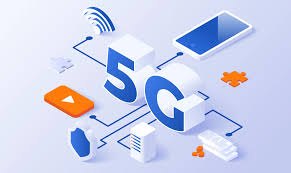Understanding 5G Technology: The Future of Connectivity Explained
In a world increasingly reliant on digital technology, connectivity is everything. From streaming high-definition videos to enabling smart cities, the way we connect to the internet and to each other defines our daily lives. Enter 5G—the fifth generation of mobile network technology.
5G is not just a faster version of 4G; it’s a technological revolution that promises ultra-fast internet speeds, minimal latency, and massive device connectivity. In this blog, we’ll break down what 5G is, how it works, its key benefits, and how it’s transforming various industries in 2025.
📱 What is 5G?
5G stands for the fifth generation of mobile networks, following the previous generations:
1G – Analog voice (1980s)
2G – Digital voice and SMS (1990s)
3G – Mobile data and internet access (2000s)
4G – High-speed internet and video streaming (2010s)
5G was officially launched in many countries around 2020, and by 2025, it has become widely adopted across the globe.
Key Features of 5G:
Speed: 5G can deliver speeds up to 10 Gbps, nearly 100 times faster than 4G.
Low Latency: Latency can go as low as 1 millisecond, enabling real-time interactions.
High Bandwidth: Can support millions of devices per square kilometer.
Energy Efficiency: Optimized for lower energy consumption, especially for IoT devices.
🌐 How Does 5G Work?
To understand how 5G works, it’s essential to grasp some basic concepts of spectrum and network architecture.
1. Radio Frequency Spectrum
5G uses three types of frequency bands:
Low-band (Below 1 GHz): Offers wider coverage but slower speeds.
Mid-band (1 GHz–6 GHz): Balanced between speed and coverage.
High-band (Millimeter wave or mmWave): Extremely fast but limited to short distances.
These frequencies allow telecom providers to balance coverage, speed, and capacity, depending on the environment (urban, suburban, rural).
2. Small Cells and Massive MIMO
To support higher data rates, 5G networks use:
Small Cells: Mini base stations placed every few hundred meters for dense urban areas.
Massive MIMO (Multiple Input, Multiple Output): Uses multiple antennas to send and receive more data simultaneously.
Together, these technologies allow 5G to handle more data, serve more devices, and maintain high-quality connections.
🚀 Advantages of 5G Technology
Let’s look at some of the key advantages that make 5G revolutionary:
1. Blazing Fast Speeds
Downloading a full HD movie in seconds or streaming 8K video without buffering—5G makes this a reality. It’s a major upgrade for content consumers, gamers, and professionals who rely on cloud computing.
2. Ultra-low Latency
Low latency enables:
Real-time gaming
Remote surgery
Self-driving vehicles
It minimizes the delay between command and action, critical for applications requiring instant responses.
3. Massive IoT Connectivity
5G can connect billions of devices at once, including:
Smart home appliances
Traffic sensors
Industrial machines
Health monitoring devices
This level of connectivity fuels the growth of the Internet of Things (IoT) ecosystem.
4. Improved Network Efficiency
With network slicing, 5G allows multiple virtual networks to run on a single physical network. For instance:
One slice for streaming
One for emergency services
One for industrial automation
Each gets its own performance guarantees.
🏙️ Real-World Applications of 5G in 2025
1. Smart Cities
5G enables smart infrastructure like:
Traffic light optimization
Smart waste management
Surveillance and safety systems
Governments can use real-time data to manage cities more efficiently.
2. Healthcare
In telemedicine, 5G allows:
Live HD video consultations
Remote surgeries using robotic arms
Continuous health monitoring via wearables
It’s transforming healthcare accessibility and precision.
3. Autonomous Vehicles
Self-driving cars rely on 5G to:
Communicate with other vehicles (V2V)
Receive traffic updates in real time
React instantly to road conditions
This reduces accidents and increases road safety.
4. Industrial Automation (Industry 4.0)
Factories are using 5G for:
Real-time machine monitoring
Predictive maintenance
Robot coordination
This improves productivity and reduces downtime.
5. Entertainment & Gaming
Gamers and streamers enjoy:
Cloud gaming with no lag (e.g., Xbox Cloud, NVIDIA GeForce Now)
Augmented reality (AR) and virtual reality (VR) experiences
Multi-device streaming with no drop in quality

🌍 Global Adoption of 5G
As of 2025:
Countries like South Korea, USA, China, and Finland lead in 5G infrastructure.
5G devices are standard in most smartphones.
5G networks cover over 70% of urban areas globally.
Private 5G networks are growing in industries like aviation, shipping, and energy.
Even developing countries are leveraging 5G for digital transformation, using it to bridge the digital divide.
⚠️ Challenges and Concerns
Despite its advantages, 5G comes with its own set of challenges:
1. Infrastructure Costs
Building 5G infrastructure (especially small cell towers) is expensive and time-consuming.
2. Limited Rural Coverage
Due to the short range of high-band frequencies, rural areas often experience slower adoption.
3. Device Compatibility
Users need 5G-compatible smartphones, routers, and IoT devices to access the network.
4. Security and Privacy
With more devices connected, the risk of cyberattacks and data breaches increases. Network security must evolve alongside the technology.
🧠 The Future of 5G
The future of 5G is about more than speed. It’s about possibility. In the coming years, we can expect:
6G research and development to begin, promising even more immersive experiences.
AI and 5G integration for smarter networks.
Global expansion into rural and underserved communities.
With innovation continuing at a rapid pace, 5G is the foundation upon which much of our future technology—from metaverses to smart robots—will be built.
📝 Conclusion
5G is more than a new mobile network—it’s a transformative force reshaping industries, cities, and personal experiences. Its unmatched speed, ultra-low latency, and massive device connectivity open up a world of opportunities.
As 5G continues to evolve and expand, it will power innovations we’ve only dreamed of—from AI-driven cars to remote surgeries and beyond. Whether you’re a consumer, a business, or a nation, the 5G revolution is here, and it’s changing everything.